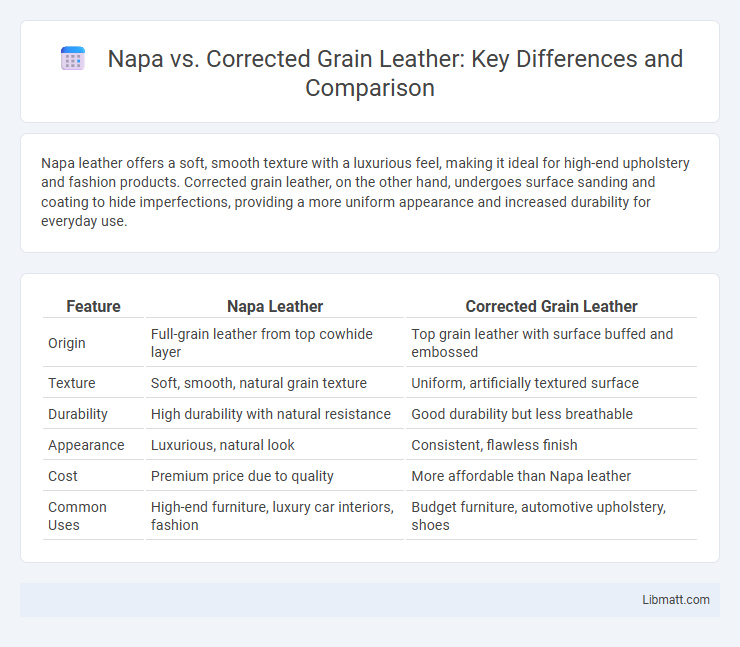Napa leather offers a soft, smooth texture with a luxurious feel, making it ideal for high-end upholstery and fashion products. Corrected grain leather, on the other hand, undergoes surface sanding and coating to hide imperfections, providing a more uniform appearance and increased durability for everyday use.
Table of Comparison
| Feature | Napa Leather | Corrected Grain Leather |
|---|---|---|
| Origin | Full-grain leather from top cowhide layer | Top grain leather with surface buffed and embossed |
| Texture | Soft, smooth, natural grain texture | Uniform, artificially textured surface |
| Durability | High durability with natural resistance | Good durability but less breathable |
| Appearance | Luxurious, natural look | Consistent, flawless finish |
| Cost | Premium price due to quality | More affordable than Napa leather |
| Common Uses | High-end furniture, luxury car interiors, fashion | Budget furniture, automotive upholstery, shoes |
Introduction to Napa and Corrected Grain Leather
Napa leather is renowned for its smooth, soft texture and fine grain, created through minimal processing to preserve the natural surface of the hide. Corrected grain leather undergoes surface treatment to remove imperfections, followed by embossing to simulate a uniform grain pattern, making it more durable and resistant to wear. Your choice between Napa and corrected grain leather depends on the desired look and durability for your leather goods.
Defining Napa Leather: Features and Origins
Napa leather originates from a specific tanning process developed in Napa Valley, California, known for its exceptionally soft, smooth texture and fine grain structure. This type of leather is typically made from full-grain or top-grain hides, retaining the natural surface with minor imperfections that enhance its durability and breathability. Your choice of Napa leather guarantees a premium feel and distinctive natural look compared to corrected grain leather, which undergoes surface sanding and embossing to mask defects.
What is Corrected Grain Leather?
Corrected grain leather is a type of cowhide that has undergone a surface treatment to remove imperfections such as scars and blemishes, then coated with a finish to create a uniform appearance. Unlike Napa leather, which retains the natural grain and softness of the hide, corrected grain leather is more durable and resistant to wear but lacks the breathable quality of full-grain options. Your choice between Napa and corrected grain leather depends on whether you prioritize natural texture or enhanced durability for your leather goods.
Key Differences Between Napa and Corrected Grain
Napa leather, known for its soft, smooth texture and natural grain patterns, contrasts with corrected grain leather that features an artificially embossed surface to mask imperfections. You will find Napa offers superior breathability and a more luxurious feel, while corrected grain is more durable and resistant to stains due to its treated finish. Understanding these key differences helps in choosing the right leather for applications where appearance versus durability prioritizes your needs.
Appearance and Texture Comparison
Napa cabbage exhibits pale green, tightly packed leaves with a crisp texture ideal for fresh salads and stir-fries. Corrected grain, a processed cereal product, presents a uniform, finer appearance and a gritty, granular texture suited for baking and brewing applications. The visual contrast between Napa's leafy layers and corrected grain's uniform particles highlights their distinct culinary uses and tactile experiences.
Durability and Longevity Analysis
Napa leather exhibits superior durability due to its full-grain structure, which maintains the natural fiber integrity and resists wear over time. Corrected grain leather undergoes surface alterations including sanding and embossing, which can reduce its longevity as the top grain is compromised. As a result, Napa leather typically offers enhanced longevity and better aging characteristics, making it ideal for products requiring sustained durability.
Cost and Value Considerations
Napa fabric generally commands a higher price due to its premium quality, softness, and durability, making it a valuable choice for luxury leather products. Corrected grain leather is more cost-effective, offering a budget-friendly alternative while sacrificing some natural texture and breathability. The decision between Napa and corrected grain leather hinges on balancing upfront costs against long-term value and aesthetic preferences.
Common Uses in Fashion and Upholstery
Napa leather is prized in fashion for its soft, buttery texture and durability, making it a top choice for high-end handbags, jackets, and gloves. Corrected grain leather, with its uniform finish and resistance to stains, is commonly used in upholstery, especially for furniture and car interiors where durability and ease of maintenance are essential. Your selection depends on whether you prioritize the luxurious feel of Napa or the practical resilience of corrected grain leather for your project.
Pros and Cons: Napa vs Corrected Grain
Napa leather offers a soft, smooth texture and breathability, making it ideal for comfortable, high-end products, but it is prone to scratching and requires more maintenance. Corrected grain leather undergoes surface treatment to hide imperfections, enhancing durability and stain resistance, yet it may lack the natural, luxurious feel of Napa. Your choice depends on whether you prioritize the premium softness of Napa or the rugged, practical resilience of corrected grain.
How to Choose: Napa or Corrected Grain for Your Needs
Choosing between Napa and corrected grain leather depends on your desired texture and durability; Napa offers a smooth, soft finish ideal for luxury items, while corrected grain features enhanced toughness suited for high-use products. Consider your specific requirements for appearance and wear resistance, as Napa's supple feel suits accessories and apparel, whereas corrected grain withstands rougher conditions better. Your selection should balance aesthetics and practicality to match your lifestyle or project demands.
Napa vs corrected grain Infographic

 libmatt.com
libmatt.com